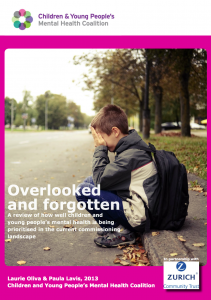
The statistic that one in four adults in Britain will experience a mental health problem in any given year is well known (if still debated), but a recent report by the Children and Young People’s Mental Health Coalition revealed a lack of such statistics for children. The report also highlighted that Office for National Statistics (ONS) figures were the most common data source for calculating local prevalence used in needs assessments. Therefore the current prevalence of mental health problems in children and young people in Britain is unknown.
Early interventions (either in terms of the illness or the individual) are increasingly seen as valuable in reducing the number of people experiencing mental health problems. School is seen as a potentially valuable setting for early psychological interventions, earlier this month Amy Broadbent blogged on the Mental Elf about school-based interventions for treating depression and anxiety in children.
A recent study by Deighton et al in the Journal of Psychoeducational Assessment was conducted by researchers based in England, who found that children with behavioural difficulties who received Targeted Mental Health Support (TaMHS) in their primary school showed a statistically significant reduction in self-reported behavioural difficulties one year later.

The recent (Dec 2013) Overlooked and Forgotten report from the Children and Young People’s Mental Health Coalition is well worth reading
Methods
This was a randomised controlled trial in which 65 Local Authorities (LAs) across England were allocated to either receive TaMHS or control (usual practice), with 8,172 pupils across 266 schools included in the final analysis. The intervention was targeted at children who reported behavioural difficulties that were considered to be borderline-clinical.
The key elements of the TaMHS framework were:
- Child-focused support (such as one-to-one therapy)
- Parent-focused support (such as information about available services)
- Staff-focused support (such as training)
The specific interventions offered varied between LAs as they were encouraged to develop their own model of school-based support from the framework.
The primary outcome of “behavioural difficulties” was measured via a survey, using the behavioural difficulties subscale of the Me and My School (M&MS, Deighton et al 2013) measure, completed by the children in 2009 (pre-test) and in 2010 (post-test).
Demographics
- The demographics of the children were broadly similar in the control and intervention groups
- However, the authors reported that children in the intervention group had significantly higher average Income Deprivation Affecting Children Index scores (IDACI; M=-0.30) than those in the control group (M=0.29, p=<0.001)
- The study sample also differed from national averages with:
- Lower levels of attainment (study sample=15.02, national average=15.30)
- Greater levels of deprivation (study sample=0.30, national average=0.24)
- A higher proportion of children eligible for free school meals (FSM, study sample=24.5%, national average=17.3%)
- A lower proportion of children listed under the “White British” ethnic category (study sample=70.6%, national average=73.8%)
Authors used a multilevel model to analyse the data and test the influence of a number of variables, such as IDACI score and attainment, which might also affect the results.

The children included in the study were in some ways different from the ‘national average’ UK population
Results
The intervention group showed a statistically significant reduction of 0.39 (p=<0.01) in their M&MS score in children above the borderline-clinical threshold for behavioural problems. This paper reported the key findings of the study.
Conclusions
The authors concluded that:
Our findings add to a growing body (e.g. Horner, 2009; Slee et al., 2009) indicating that there are grounds for using approaches other than single, highly prescriptive manualised interventions and that in fact adopting a range of approaches allowing adaptation based on local needs can have positive effects that benefit vulnerable children.
Sum up
This study was based on the use of a framework of interventions to provide an early intervention in children identified, through their borderline-clinical behavioural difficulties, as potentially at risk of mental health problems. A framework approach was chosen to provide a toolkit of potential interventions that LAs could tailor to local needs. Although the use of the framework by LAs was mandated, this approach may be generally more acceptable to LAs than specific interventions as it allows greater flexibility to suit local need, current service provision, etc.
The study has several strengths, particularly its randomised controlled design and a large sample size resulting from being part of a nationally mandated project. The major limitation of the study is the reliance on child-reported outcome data, but this is openly acknowledged by authors. The use of blinded assessors could have reduced this potential bias, however, this would have increased the cost of the study and authors often have to balance such practical factors when designing their research projects, particularly in a large publicly-funded project.
The children in this study were generally more deprived and had lower attainment than the national average, with the intervention group having greater levels of deprivation than the control group. Deprivation and poor education are generally accepted risk factors for mental health problems. Therefore the findings are even more compelling as it shows the effectiveness of this framework of interventions in a particularly vulnerable sample.

Flexibility is key! Giving local authorities the freedom to develop their own models of school-based support bore fruit in the context of this research
Links
Deighton, J., Tymms, P., Vostanis, P., Belsky, J., Fonagy, P., Brown, A., Martin, A., Patalay, P. & Wolpert, M. (2013). The development of a school-based measure of child mental health. Journal of Psycho-educational Assessment, 31(3), p.247–257.
Oliva L and Lavis P. Overlooked and forgotten: A review of how well children and young people’s mental health is being prioritised in the current commissioning landscape (full report). Children and Young People’s Mental Health Coalition, 2013. (Executive summary)
Mental health: deprivation. Scottish Public Health Observatory, 2013.
A good start in life. The UK’s Faculty of Public Health.

Targeted mental health support can improve borderline-clinical behavioural problems in children: The statistic… http://t.co/6Tmd0wLpGH
@ellyob reports on a recent RCT looking at the development of a school-based measure of child mental health http://t.co/ABFRxj1C2Z
School-based interventions can reduce borderline-clinical behavioural problems http://t.co/ABFRxj1C2Z
RCT argues that we shld be giving local authorities freedom to develop their own models of school-based MH support http://t.co/ABFRxj1C2Z
School is seen as a potentially valuable setting in reducing mental health problems http://t.co/fqUKRzfo9j via @Mental_Elf
The current prevalence of mental health problems in children and young people in Britain is unknown http://t.co/ABFRxj1C2Z
Study shows a variety of school-based interventions reduce borderline-clinical behavioural problems http://t.co/ABFRxj1C2Z
School-based interventions can reduce borderline-clinical behavioural problems, even in above-average deprived sample http://t.co/ABFRxj1C2Z
Don’t miss: Targeted mental health support can improve borderline-clinical behavioural problems in children http://t.co/ABFRxj1C2Z
Targeted mental health support can improve borderline-clinical behavioural problems in children http://t.co/QZX5m5XhAY #rvsed
Mental Elf: Targeted mental health support can improve borderline-clinical behavioural problems in children http://t.co/KuIpN8ZszS
Targeted mental health support can improve borderline-clinical behavioural problems in children – The Mental Elf http://t.co/BYPqWvzfbR
Interesting… Targeted mental health support can improve borderline-clinical behavioural problems in children http://t.co/E808Kdsynk
my MD research in this subject so how can I get the full text